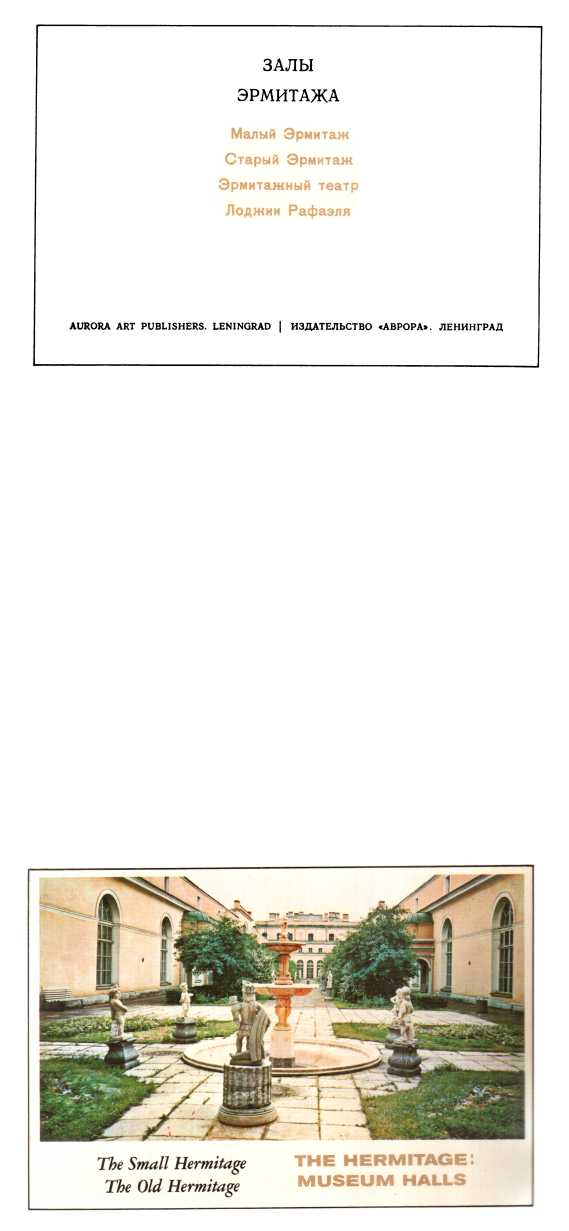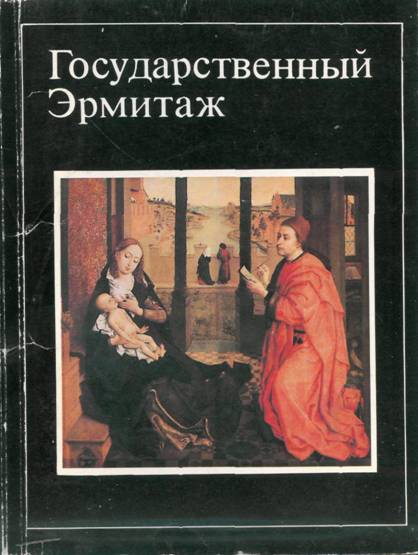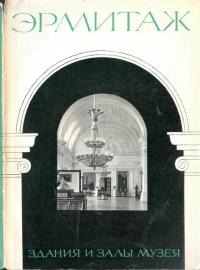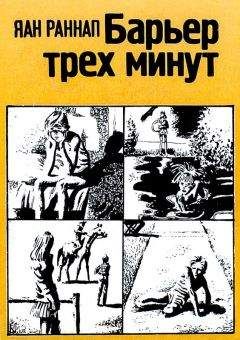The Hermitage: Museum halls
Эрмитаж: Залы Эрмитажа
© Aurora Art Publishers, Leningrad, 1979 Издательство «Аврора», Ленинград, 1979
Комплект — 16 открыток. Составитель Т. Соколова. Художник С. Дурандин. Редактор М. Григорьева. Художественный редактор С. Дьяченко. Технический редактор А. Донияхи. М12144. 25.05.79. Изд. № 3047. Тираж 380 000. Цена 54 коп. Заказ 3301. 2221211. Офсет. ЛФОП 1, ул. Мира, 3.
Printed in the USSR
THE SMALL HERMITAGE is one of the oldest of the buildings which formed the architectural complex of the Hermitage in the centre of St Petersburg, most of them dating from the second half of the eighteenth century. It was built alongside the Winter Palace in 1764—76 by the architect Yury Velten in the style of Early Classicism (its northern pavilion facing on to the Neva was built according to a design by Jean-Baptiste Vallin de la Mothe). Inside were displayed the art collections which formed the basis of the world-famous museum and art gallery. The collections grew quickly and in 1771—87 Velten put up a new building alongside and in line with the Small Hermitage. The new building came to be known as the Old (or Great) Hermitage. The interior decor of both buildings underwent substantial changes in the mid-nineteenth century when they were redesigned by Andrei Stakenschneider in a mixture of architectural styles from the past. The complex of buildings which runs along the Neva embankment is completed by the severe classical facade of the Hermitage Theatre, built in 1773—87 by the architect Giacomo Quarenghi. The auditorium, conceived like a Roman amphitheatre, has preserved its late eighteenth century appearance despite numerous alterations over the years. The arch linking the Theatre to the rest of the Hermitage contains a foyer designed by Leonty Benois in 1904. The building known as Raphael’s Loggias was erected along the banks of the Winter Canal under the supervision of Quarenghi. It is an exact copy of the loggias in the Vatican which Raphael and his pupils decorated with frescoes. The interior design of the Hermitage halls and rooms is itself a monument to Russian architecture and decorative art of the eighteenth and nineteenth centuries and therefore may be considered as much worthy of the visitor’s attention as the art collections preserved within their walls.
T. Sokolova
МАЛЫЙ ЭРМИТАЖ — одно из первых сооружений архитектурного ансамбля Эрмитажа, который возник во второй половине XVIII века в центре Петербурга, — был построен рядом с Зимним дворцом в 1764—1776 годах архитектором Ю. М. Фельтеном в стиле раннего классицизма (северный павильон его, выходящий фасадом на Неву, выполнен по проекту Ж.-Б. Валлен-Деламота). Здесь были размещены художественные коллекции, положившие начало формированию всемирно известного музея. Коллекции быстро росли, и в 1771—1787 годах Фельтен построил «в линию» с Малым Эрмитажем здание, впоследствии получившее название Старый (или Большой) Эрмитаж. Внутренняя отделка этих первых музейных зданий в середине XIX века претерпела значительные изменения, осуществленные архитектором А. И. Штакеншнейдером, использовавшим в украшении интерьера элементы различных архитектурных стилей прошлого. Ансамбль на набережной Невы завершает строгий классический фасад Эрмитажного театра, возведенного в 1773—1787 годах архитектором Дж. Кваренги. Зрительный зал, решенный как амфитеатр, несмотря на многочисленные переделки, сохранил облик конца XVIII века. Над аркой, соединяющей театр с другими зданиями Эрмитажа, помещается фойе, отделанное Л. Н. Бенуа в 1904 году. Здание Лоджий Рафаэля, расположенное вдоль берега Зимней канавки, построено Кваренги. Это копия Лоджий Ватикана, возведенных и украшенных фресками под руководством Рафаэля. Художественное убранство залов Эрмитажа, своеобразный памятник русской архитектуры и декоративноприкладного искусства XVIII—XIX веков, является частью богатейшей экспозиции музея.
Т. Соколова
The Small Hermitage: The Pavilion Hall
The Small Hermitage: The Pavilion Hall
Yury Velten, 18th century
Andrei Stakenschneider, 1850—58
Павильонный зал. Малый Эрмитаж
Ю. М. Фельтен, XVIII в. А. И.
Штакеншнейдер, 1850—1858
© Aurora Art Publishers, Leningrad, 1979. Издательство «Аврора», Ленинград, 1979. Printed in the USSR. 3 коп.
The Small Hermitage: The Pavilion Hall
The Small Hermitage: The Pavilion Hall
Yury Velten, 18th century
Andrei Stakenschneider, 1850—58
Павильонный зал. Малый Эрмитаж
Ю. М. Фельтен, XVIII в.
А. И. Штакеншнейдер, 1850—1858
The Small Hermitage: The Pavilion Hall
The Small Hermitage: The Pavilion Hall
Yury Velten, 18th century
Andrei Stakenschneider, 1850—58
Павильонный зал. Малый Эрмитаж
Ю. М. Фельтен, XVIII в.
А. И. Штакеншнейдер, 1850—1858
The Small Hermitage: The Apollo Room
The Small Hermitage: The Apollo Room
Giacomo Quarenghi, 1793
Vasily Stasov, 1844
Аполлонов зал. Малый Эрмитаж
Дж. Кваренги, 1793; В. П. Стасов, 1844
The Small Hermitage: The Hanging Garden
The Small Hermitage: The Hanging Garden
Vasily Stasov, 1840—44
Висячий сад. Малый Эрмитаж
В. П. Стасов, 1840—1844
The Small Hermitage: The West Gallery
The Small Hermitage: The West Gallery
Vasily Stasov, 1840—44
Западная галерея. Малый Эрмитаж
В. П. Стасов, 1840—1844
The Small Hermitage: The Quarenghi Room
The Small Hermitage: The Quarenghi Room
Giacomo Quarenghi, 1806
Andrei Stakenschneider, 1850—58
Кабинет Кваренги. Малый Эрмитаж
Дж. Кваренги, 1806.
А. И. Штакеншнейдер, 1850—1858
The Old Hermitage: Room of Early Renaissance art
The Old Hermitage: Room of Early Renaissance art
Andrei Stakenschneider, 1858
Зал искусства раннего Возрождения. Старый Эрмитаж
А. И. Штакеншнейдер, 1858
The Old Hermitage: The northern suite
The Old Hermitage: The northern suite
Andrei Stakenschneider, 1858
Северная анфилада, Старый Эрмитаж
А. И. Штакеншнейдер, 1858
The Old Hermitage: The northern suite
The Old





